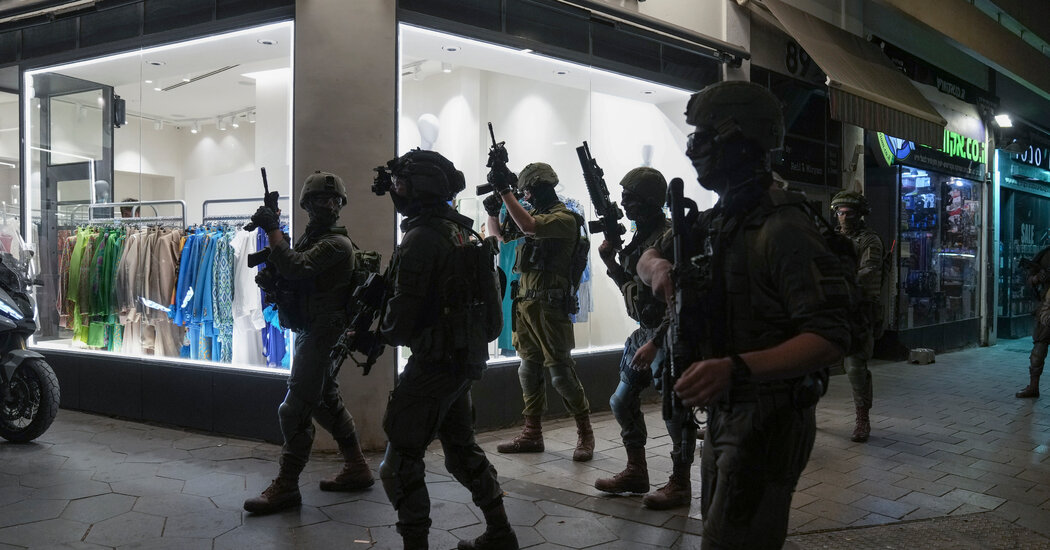
JERUSALEM — A gunman remained at large early Friday after killing at least two people and injuring 13 others in an attack on Thursday night outside a bar on a busy street in central Tel Aviv, the latest in the deadliest wave of terrorism in Israel since 2016.
Medics and the police said the shooting occurred at around 9 p.m. on the last night of the Israeli workweek, outside a bar filled with people enjoying the start of the weekend. Nearly three hours later, the police and the military still had not located the shooter or shooters and the police instructed residents to stay home, effectively placing central Tel Aviv under a lockdown.
The shooter’s disappearance set off a surreal manhunt in the heart of Israel’s most cosmopolitan city, after the army sent special forces to assist in the search. Soldiers in full combat gear ran through the city center searching for the shooter, many of them filmed live by journalists who jogged beside them.
The shooting was the fourth lethal attack in Israel in less than three weeks, and brought the total death toll since March 22 to 13. The assault heightened fears of an even more intense surge of violence over the next 10 days, when the rare convergence of Ramadan, Passover and Easter is expected to raise tensions further between Israelis and Palestinians.
Ten casualties were taken to Ichilov Hospital in Tel Aviv, two of whom later died and four of whom were in critical condition, the hospital said. Another five injured people were treated elsewhere, the police said.
One injured man said he initially had not realized he was hurt. After hearing the shots outside the bar and seeing its window shatter, the man, Mark Malfeyev, said he began sprinting to safety. “I did not know I had an injury, and I just started running,” Mr. Malfeyev said in a video filmed from his hospital bed and broadcast by Kan, the Israeli public broadcaster. “Then I saw a lot of blood.”
Witnesses described scenes of panic in the immediate aftermath of the shooting, as survivors ran to take shelter in nearby apartment buildings, bar basements and elevators, some of them knocking on the doors of strangers to find shelter.
Broadcasters later showed video footage of soldiers going from apartment to apartment in central Tel Aviv, knocking on doors as they searched for the shooter.
Medics at the scene said it summoned memories of past attacks in Israel, including a wave of violence between 2000 and 2005, known as the second Palestinian intifada, or uprising, that killed at least 1,000 Israelis and 3,000 Palestinians.
“There are a lot of people who are still hiding and who are very stressed,” said Shragi Kirschenbaum, a medic for United Hatzalah, an emergency medical service that treated victims at the scene. “It’s been like this since I was born. I am 37 years old — I don’t think I had a year without a war or some kind of terror attack.”
Yisrael Weingarten, a paramedic with Magen David Adom, another emergency medical group, treated some of the victims, and said he witnessed “a large commotion at the scene, with dozens of people running in the streets,” and saw six people “lying on the sidewalk.”
The attack on Thursday occurred 10 days after a gun attack in Bnei Brak, a city just east of Tel Aviv, in which a Palestinian attacker killed three Israelis and two Ukrainians.
That episode came just two days after a gun attack in which two Arab citizens of Israel, armed with heavy automatic weapons, fatally shot two police officers in Hadera, a coastal city in northern Israel.
The Recent Rise in Terrorist Attacks in Israel
A rash of violence. The recent wave of terrorism across Israel has become one of the deadliest periods in the country in several years. A shooting on April 7 was the fourth lethal attack since March 22, and brought the total death toll in recent weeks to at least 13 people.
The string of deadly attacks began March 22, when an assailant stabbed three people and rammed another with his car in a city in southern Israel, killing all four. Before the March 22 assault, there had also been two other nonlethal stabbing attacks in the space of a week in Jerusalem.
Most attacks in recent years have been carried out with knives, so the surge in the use of firearms has been of particular concern to security officials, because it implies an unusual level of forethought and resources.
At the time of the attack, the Israeli prime minister, Naftali Bennett, was visiting the Israeli Army headquarters in a nearby district of Tel Aviv, and was briefed there about the assault.
The motivations of the recent attackers have varied. Three of the attackers have been Arab citizens of Israel who were believed to support the Islamic State, the extremist group that is not part of the Palestinian nationalist movement. The shooter in Bnei Brak was a Palestinian from the occupied West Bank who had previously served 30 months in an Israeli jail for conspiracy to commit manslaughter and for throwing objects at vehicles.
No Palestinian militant group claimed responsibility for any of the attacks, but some groups, including Hamas, the Islamist militant group based in the Gaza Strip, praised them and said that they were a natural response to the Israeli occupation. Israel has occupied the West Bank since 1967 and, with Egypt, has maintained a blockade of the Gaza Strip since 2007.
While the Palestinian Authority manages about 40 percent of the West Bank, the Israeli Army still conducts daily raids even in areas run by the authority, and Israel operates a two-tier justice system in the territory — one for Israeli settlers and one for Palestinians.
Mr. Kirschenbaum, the medic, said he took heart from the presence of both Arab and Jewish emergency responders at the scene. “We’re all working together against terror, to save lives,” he said. “Jews and Arabs together,” he added.
Rawan Sheikh Ahmad contributed reporting from Haifa, Israel.




